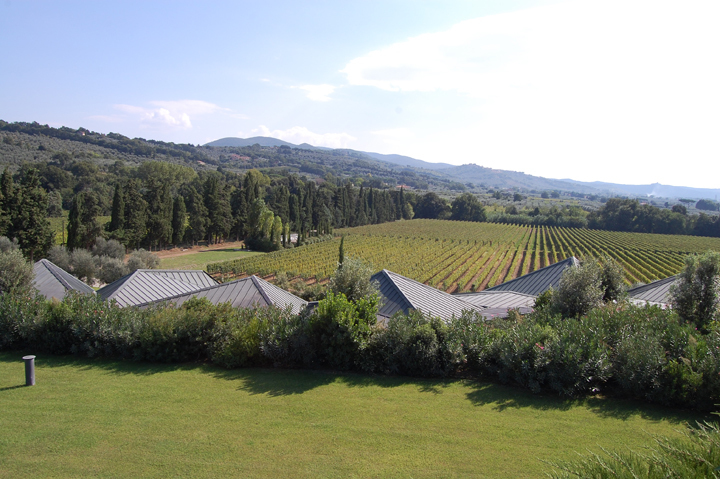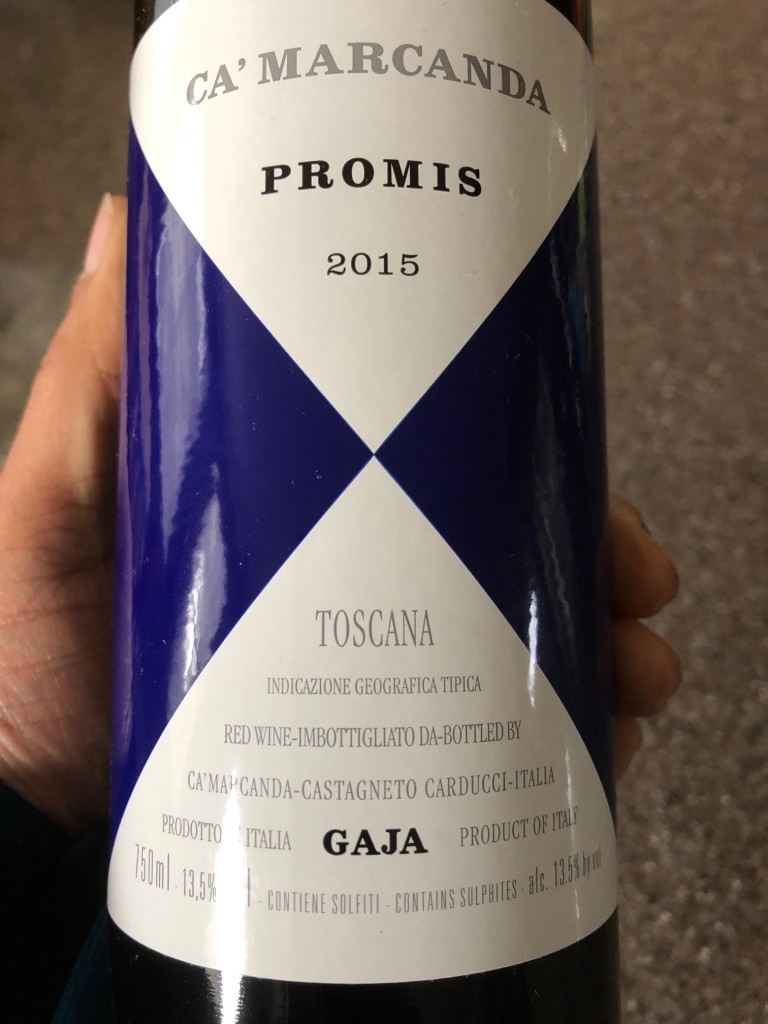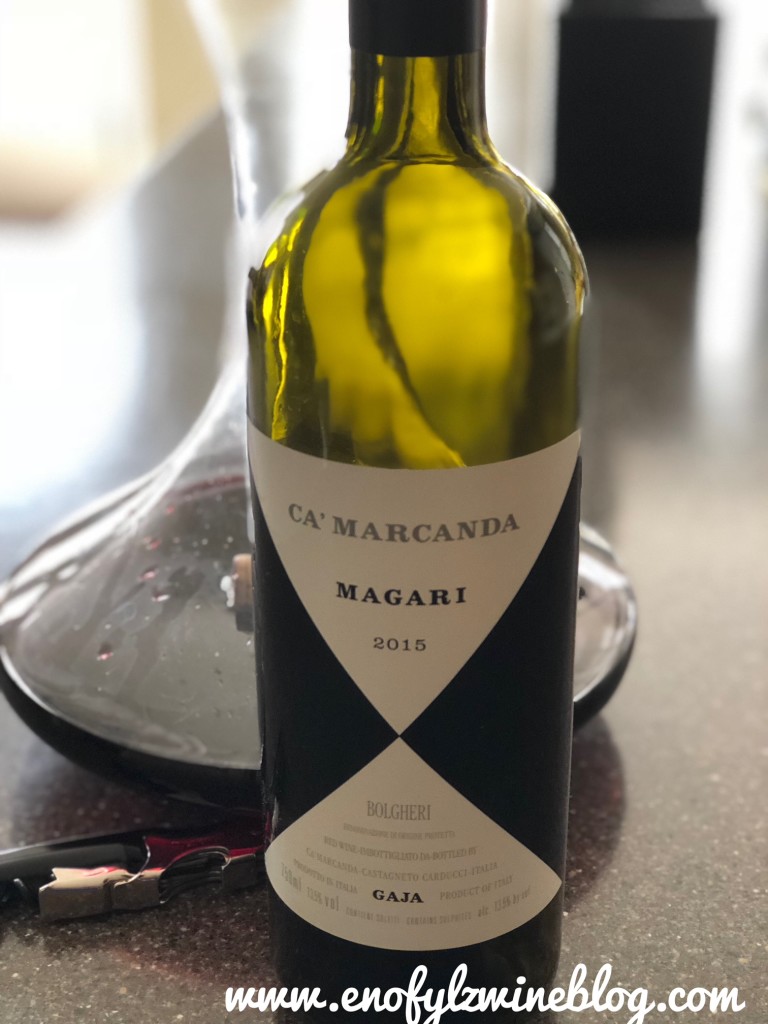Last month I participated in the #wineStudio Ca Marcanda program. The online wine education program, which included a virtual tasting of a two samples of Ca Marcanda wines, was held each held each Tuesday in March.
What I appreciate about #winestudio is the opportunity to learn about new-to-me wines and/or wine regions. The Ca Marcanda program checked both boxes for me because I’d never tried a wine from the Bolgheri (BOHL-geh-ree) DOC, or Ca Marcanda.
Before diving into Ca Marcanda and the wines, here’s some background on the Bolgheri wine region.
About Bolgheri
At at glance: (Source)
Region: Tuscany
History: Established as a DOC in 1983; Bolgheri Sassicaia split off as a separate DOC in 2013
Vineyard Area: 888 ha / 2,193 acres (2014)
Production: 42,100 hl / 467,800 cases (2014)
Principal White Grape Varieties: Sauvignon Blanc, Vermentino
Principal Red Grape Varieties: Cabernet Franc, Cabernet Sauvignon, Merlot, Sangiovese, Syrah
Red Wine Styles and Wine Composition: Bolgheri Rosso or Rosso Superiore may be made entirely from Cabernet Sauvignon, Cabernet Franc, Merlot, or a blend combining one or more of these, and/or up to 50 percent of Syrah or Sangiovese. Other red grapes such as Petit Verdot may account for up to 30 percent. Wines made from other grape varieties or nonconforming blend percentages are classified as IGTs.
Bolgheri is birthplace of modern Italian wine. It’s located in the far western corner of Tuscany, along the coast of the Tyrrhenian Sea in an area known as the Maremma. Bolgheri is perhaps the Italians’ best-kept secret.

The modern history of Bolgheri began at the end of World War II when Marchese (marquis) Mario Incisa got the idea to plant Cabernet Sauvignon grapes on his estate, in an area otherwise known only for rustic Sangiovese and Trebbiano wines. Liking the results, he planted his Sassicaia vineyard with Cabernet in the early 1960s. Thereafter,collaborating with his brother-in-law Nicolò Antinori and winemaker Giacomo Tachis, he improved his Sassicaia wines during the 1970s. The wines gained international fame in 1978, when in a blind tasting arranged by Decanter Magazine, the 1972 vintage of a largely unknown wine called Sassicaia, made at Incisa’s Tenuta San Guido estate, beat a number of top Bordeaux wines.
Sassicaia’s reputation attracted other winemakers who were interested in exploring the possibilities Incisa had demonstrated and making great wines primarily with French grapes.
In 1983, Bolgheri was established as a DOC—for white and rosato wines only (never mind that it was red wine that was the region’s claim to fame). The red wines of the area, including Sassicaia, were not recognized by the Italian government, were classified along like legion’s of ordinary table wine as merely Vino da Tavola (“VDT”) The preposterousness of Sassicaia being classified the same as ordinary table wines gave rise to the unofficial term “Super-Tuscan” – for “maverick” producers like Sassicaia, Tignanello, Solaia and Ornellaia crafting non-traditional blended wines in the region. The term lost its luster when anyone and everyone in Tuscany started to call their wines Super Tuscans.
The DOC rules were finally revised in 1994 to encompass Cabernet-based red wines. Additionally, the VDT classification was replaced with “I.G.T.” (typical of the geography) in 1994. Since 2013 Sassicaia has its own subzone DOC – Bolgheri Sassicaia DOC which is expected to become a DOCG in time.
The DOC is planted to 37% Cabernet Sauvignon, 23% Merlot, 12% Cabernet Franc, 6.5% Petit Verdot, 6% Syrah, and 1.5 % Sangiovese. Whites grapes are less than 10%.
Wine tourism in the area gained a considerable boost with the opening in 2017 of the World Wine Town, designed by Oscar-winning art director Dante Ferretti and located in Casone Ugolino, a former 16th-Century farm in Castagneto Carducci in the heart of the DOC zone. As well as the the MuSeM Sensory and Multimedia Wine Museum, the complex features restaurants, shops wine and cookery schools and conference facilities according to winesearcher.com.
About Ca Marcanda
Gaja.
The family occupies a space in the pantheon of influential world-class Italian wine producers. The Gaja winery was founded in Piedmont in 1859 with only two (five acres) hectares of land by Giovanni Gaja. Today, it is run by Gaia Gaja, the fifth generation of the family to make wine in Barbaresco.
But it is her father, Angelo Gaja who is credited with the winery’s modern success, and elevation to world-class wine estates.
He began working at the family winery in 1961 after completing studies in enology at Alba and Montpellier. Inspired by contemporary and traditional winemaking approaches in France, in the 1960’s he began to apply his experiences to the family winery. While maintaining his family’s high standards of production he inaugurated a new stylistic direction. He introduced barrique aging, hybrid French bottle formats and longer corks, and clonal and massal selection in the vineyard. In the process, he single-handedly established Barbaresco as one of the great appellations of the world.
We don’t sell Barbaresco, Barolo, Bolgheri or Brunello,we sell Gaja. – Angelo Gaja
While the family is firmly rooted in Piedmont, over the years it has expanded into Tuscany. First Angelo purchased vineyards in Montalcino (Pieve Santa Restituta )in 1994.
Then in 1996, he purchased his second Tuscan property, called Ca’ Marcanda, located in Castagneto Carducci in Bolgheri.
It took so long (18 trips in all) to complete negotiations for the historic 250-acre Bolgheri estate that the Gaja family began to call it “ca’ marcanda,” the house of endless negotiations, from the Piedmontese dialect ca’ (meaning casa or house) and marcandè (meaning mercanteggiare or to haggle).
The focus at Ca’ Marcanda is on international grape varieties, and the estate’s 150 acres were planted with Cabernet Sauvignon, Merlot, Cabernet Franc and Syrah vines in 1997.
Angelo Gaja wanted to work with Bordeaux varitities here b/c he said it was like "learning of color after only working in Black & White" #winestudio
— Terlato Wines (@terlatomedia) March 14, 2018
It took another six years for the state of the art winery to be completed in 2002. The Ca’ Marcanda winery, completely dreamed up by Angelo, was built from scratch. The layout and design allow for the precision necessary to craft exceptional wines, albeit with minimal intervention.
As you can see from the photo below, the winery is practically completely invisible.

Ca’ Marcanda stands alone as a unique contribution to the history of winemaking. The winery is itself a work of art: not only is Ca’ Marcanda one of Italy’s leading producers of wine, it is an “art object,” an art collection, and a study in ergonomics, where aesthetic ideal, humanist proportion, nature, and functionality come together to create an ideal working environment.
And today, thanks to the size of Ca’Marcanda , Gaja makes more wine in Tuscany than in Piedmont.
The terroir of the Ca’Marcanda estate is noted for its unique dual soil composition: there are both terre brune (“dark earth“): predominately loam and clay
with very little limestone or stone and terre bianche (“white earth“): primarily clay and sand, rich in limestone and filled with abundant stones and pebbles
The terre brune is located closer to the Tyrrheanian Sea, while the terra bianche is located closer the hills. The map below illustrates the areas on the estate where grapes for their four wines are sourced.

The climate is Mediterranean, being so close to the ocean, very warm days, cool nights, bright light reflected off the ocean, lots of wind
Wines Tasted
2015 Ca’ Marcanda (Gaja) Promis Toscana IGT – Italy, Tuscany, Toscana IGT
The proprietary name Promis (pronounced proh-MEESS) was created by the Gaja family to denote commitment, expectation, fulfillment, and hope. The promise of quality and the reward of diligence and excellence. The grapes are grown in the terre brune (rich, dark soils) which consist primarily of loam and clay. The first vintage for this wine was 2000. A blend of 55% Merlot, 35% Syrah, and 10% Sangiovese grown in terre brune. Aged in slightly used barriques for 12 months followed by several months of bottle aging before release.
Color – Garnet
Aromas – Black fruit, dried herb, licorice, damp earth, tobacco and a hint of wet clay
Body – Medium-bodied and fresh with great texture and silky well-integrated tannins
Taste – Black cherry, blackberry, cassis, black licorice, wild fennel in the fall, and dried herbs with a very appealing savory character
Finish – Long
13.5% abv | SRP – $48 (90 pts.) Sample| Approachable, now will benefit from cellaring for 5-10 years.
2015 Ca’ Marcanda (Gaja) Magari – Italy, Tuscany, Bolgheri DOC
Magari means if only it were true!, an expression used often in Italian to express desire, hope, and a vision of a bright future. The grapes are grown in the terre brune (rich, dark soils) which consist primarily of loam and clay. The first vintage for this wine was 2000. Beginning with the 2015 vintage, Magari will be predominantly Cabernet Franc with a small addition of Cabernet Sauvignon and Petit Verdot. It’s a blend of 60% Cabernet Franc 30% Cabernet Sauvignon 10% Petit Verdot. The grapes were fermented separately. Aged in oak for 12 months followed by several months of bottle aging before release.
Tasting Notes
Color – Garnet
Aromas – Black and red fruit, dust, dark roast espresso, tar, dust, and a bit fresh green pepper
Body – Medium-bodied, fresh and juicy; focused and well-balanced
Taste – Blackberry, red currant, sour cherry, boysenberry, espresso, licorice, spice and sweet herbs with just a hint of salinity
Finish – Long, sweet and savory
13.5% abv| SRP – $65 (92 pts.) Sample| Approachable now with decanting. Will benefit from cellaring for 10-15 years
Both of these wines were outstanding!
Thanks to Terlato Wines, Ca’ Marcanda and #winestudio for the opportunity to learn about the Gaja family, their wines and Bolgheri!
About #winestudio
#winestudio is a wine education program produced by Tina Morey. Its message is interactive wine education, thus a better understanding of our world through wine and our part in that world. Questions and comments are encouraged! You can become involved in the #winestudio conversation through Twitter, Facebook and Instagram and meet new wine folks from all over the world!
________________________________________________________________________
Follow me on Twitter, Facebook, Instagram, Vivino and Delectable, for all things wine. As a wino with latent foodie tendencies, you’ll also find food and wine pairings, and food related stuff! Become a fan and join ENOFYLZ Wine Blog on Facebook. Cheers!
Copyright Notice: This entire site is Copyrighted 2010-2018. All Rights Reserved. No unauthorized copying of any section of this site is permitted. If you wish to use any part of this site, contact me. For information on Copyright Law, see the official U.S. Copyright Office home page.


Excellent wines. Great background coverage!
Thanks for the kind words Michelle! I’m looking forward to your post about Franciacorta. I wanted to pop over when we were in Milan in 2016, but we didn’t have time.
Thanks so much Michelle! I appreciate the kind words!
Great post, Martin! Makes me wish I had another bottle of the Magari in my fridge. Also appreciate the background on the development of Bolgheri as a premium wine-producing area. Cheers!
Thanks for the kind words Lauren! I really appreciate it!